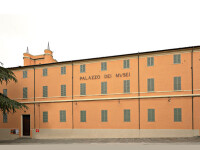Paolo Mori Review of Musei Civici di Reggio Emilia
Pleasant museum. Display of a remarkable variety o...
Pleasant museum. Display of a remarkable variety of pieces. The numerous stuffed animals are interesting.
Collections ranging from the Paleolithic to the present day presented in five museum locations, two monumental locations and three exhibition venues. A wealth of works and buildings that has grown over many decades, continually updating the proposals, and whose first nucleus begins just over 200 years ago.
The system of collections, historical places and exhibition halls proposed by the Civic Museums of Reggio Emilia has accompanied the formation of the cultural identity of the Reggio throughout time.
In the Museums, memories of nature, archeology, art and history of the entire provincial territory are documented and enhanced, in an overview that spans the five continents.
The oldest foundation of the collections, in fact, was born in 1799 with the acquisition, by the city of Reggio Emilia, of the domestic collection of the illustrious scientist Lazzaro Spallanzani who, in his home in Scandiano, had accumulated zoological, paleontological and mineralogical finds , lithological and botanical, as well as objects of furniture, such as paintings, small tables and ornaments. The collection, preserved intact in its eighteenth-century consistency, since 1830 is located in the rooms of Palazzo dei Musei.
In 1862, thanks to the work of the priest Gaetano Chierici, one of the fathers of modern Palethnology, the Gabinetto di Storia della Patria was created, which in 1870 became the Museum of National History. Precious testimonies of science and museology of the late nineteenth century, the materials of prehistory and local protohistory are compared with objects of the same period, but of different geographical origin, especially Italian. The collection was later renamed the Gaetano Chierici di Paletnologia Museum, located at the Palazzo dei Musei.
The exhibits at the Palazzo dei Musei then extend to the Galleria dei Marmi with stone artefacts, Roman epigraphs and sculptures from the Middle Ages to the XVIII century, to the Atrium of the Museums with Roman mosaics and floor decorations from the 12th and 13th centuries, and again with Salt which complete the naturalistic, zoological and botanical collections, finally arriving at collections of ethnography, numismatics, ceramics, goldsmithery and minor arts.
In 1902 the Antonio Fontanesi Gallery was established which, reorganized several times, expanded and enriched, documents the artistic culture in Reggio from the 14th to the 20th century.
The historic site of the Civic Museums, which was recently renovated by the architect Italo Rota, is now part of a network that also includes other places, and which consists of five museum sites that include, in addition to the Palazzo dei Musei , the Parmeggiani Gallery, the Tricolore Museum, the Museum of the History of Psychiatry and the Museum of the Sanctuary of the Beata Vergine della Ghiara. The network also includes two monumental sites (the Synagogue and the Mauritian) and the Library of the Arts.
The Civic Museums, pursuing the goal of preserving the testimonies of the city of Reggio Emilia and the province of Reggio, have simultaneously promoted scientific research, knowledge and public enjoyment also through training and educational activities.

Comments: